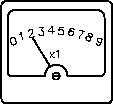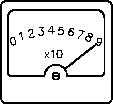CIRCUITRY AND CIRCUIT ELEMENTS
Radiation Detectors
Analog
Analog is defined as a mechanism in which data is represented by continuously variable
physical quantities. As it applies to the intermediate range, the output of the intermediate
range is an analog current. Due to the wide range of the flux measured, use of
logarithmic circuitry is required for indication on a single scale instrument. Analog is
used in contrast to digital to refer to circuits in which the magnitude of the signal carries
the information. Figure 30(A) illustrates an example of an analog display, and 30(B)
illustrates a digital display.
Figure 30 Analog and Digital Displays
Logarithm
Logarithm is defined as the exponent that indicates the power to which a number is raised
to produce a given number (i.e., the logarithm of 100 to the base 10 is 2).
When discussing nuclear instrumentation, this term refers to the electronic circuitry of the
source and intermediate ranges. These ranges utilize logarithms due to the wide range
of measured flux and the necessity to measure that flux on a single meter scale.
Reactor Period
Reactor period is defined as that amount of time, normally in seconds, required for
neutron flux (power) to change by a factor of e, or 2.718.
IC-06
Page 56
Rev. 0






